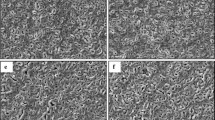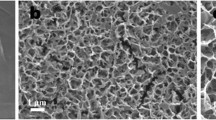Abstract
Anodic oxidation was applied to produce nanostructures on the surface of titanium (Ti) implants. The bioactivity of the Ti implants was evaluated by simulated body fluid soaking test. The biocompatibility was investigated by in vitro cell culture test. The results showed that bone-like apatite was formed on the anodized Ti surface, but not on the as-polished Ti surface after immersion in simulated body fluid for 2 weeks. Cells cultured on the anodized Ti surface showed enhanced cell adhesion and proliferation, compared to those cultured on the as-polished Ti surface. Based on these results, it can be concluded that anodic oxidation improved the bioactivity and biocompatibility of Ti surface, which was attributed to the formation of nanostructures as well as the nanostructure induced high surface roughness and hydrophilicity.





Similar content being viewed by others
References
Zhuang LF, Jiang HH, Qiao SC, Appert C, Si MS, Gu YX, Lai HC. The roles of extracellular signal-regulated kinase 1/2 pathway in regulating osteogenic differentiation of murine preosteoblasts MC3T3-E1 cells on roughened titanium surfaces. J Biomed Mater Res, Part A. 2012;100A:125–33.
Wen HB, Liu Q, De Wijn JR, De Groot K, Cui FZ. Preparation of bioactive microporous titanium surface by a new two-step chemical treatment. J Mater Sci Mater M. 1998;9:121–8.
Balasundaram G, Yao C, Webster TJ. TiO2 nanotubes functionalized with regions of bone morphogenetic protein-2 increases osteoblast adhesion. J Biomed Mater Res. 2008;84A:447–53.
Portan DV, Kroustalli AA, Deligianni DD, Papanicolaou GC. On the biocompatibility between TiO2 nanotubes layer and human osteoblasts. J Biomed Mater Res, Part A. 2012;100A:2546–53.
Minagar S, Wang J, Berndt CC, Ivanova EP, Wen C. Cell response of anodized nanotubes on titanium and titanium alloys—a review. J Biomed Mater Res, Part A. 2013;101A:2726–39.
Narayanan R, Mukherjee P, Seshadri SK. Synthesis, corrosion and wear of anodic oxide coatings on Ti–6Al–4V. J Mater Sci Mater M. 2007;18:779–86.
Nie X, Meletis EI, Jiang JC, Leyland A, Yerokhin AL, Matthews A. Abrasive wear/corrosion properties and TEM analysis of Al2O3 coatings fabricated using plasma electrolysis. Surf Coat Tech. 2002;149:245–51.
Aladjem A. Anodic oxidation of titanium and its alloys. J Mater Sci. 1973;8:688–704.
Li H, Cao L, Liu W, Su G, Dong B. Synthesis and investigation of TiO2 nanotube arrays prepared by anodization and their photocatalytic activity. Ceram Int. 2012;38:5791–7.
Gerlier D, Thomasset N. Use of MTT colorimetric assay to measure cell activation. J Immunol Methods. 1986;94:57–63.
Macak JM, Tsuchiya H, Ghicov A, Yasuda K, Hahn R, Bauer S, Schmuki P. TiO2 nanotubes: self-organized electrochemical formation, properties and applications. Curr Opin Solid State Mater Sci. 2007;11:3–18.
Zhou W, Zhong X, Wu X, Yuan L, Zhao Z, Wang H, Xia Y, Feng Y, He J, Chen W. The effect of surface roughness and wettability of nanostructured TiO2 film on TCA-8113 epithelial-like cells. Surf Coat Tech. 2006;200:6155–60.
Balasundaram G, Webster TJ. A perspective on nanophase materials for orthopedic implant applications. J Mater Chem. 2006;16:3737–45.
Kieswetter K, Schwartz Z, Humrnert TW, Cochran DL, Simpson J, Dean DD, Boyan BD. Surface roughness modulates the local production of growth factors and cytokines by osteoblast-like MG-63 cells. J Biomed Mater Res. 1996;32:55–63.
Das K, Bose S, Bandyopadhyay A. Surface modifications and cell–materials interactions with anodized Ti. Acta Biomater. 2007;3:573–85.
Advincula MC, Rahemtulla FG, Advincula RC, Ada ET, Lemons JE, Bellis SL. Osteoblast adhesion and matrix mineralization on sol–gel-derived titanium oxide. Biomaterials. 2006;27:2201–12.
Deligianni DD, Katsala N, Ladas S, Sotiropoulou D, Amedee J, Missirlis YF. Effect of surface roughness of the titanium alloy Ti6Al4V on human bone marrow cell response and on protein adsorption. Biomaterial. 2001;22:1241–51.
Liu X, Zhao X, Li B, Cao C, Dong Y, Ding C, Chu PK. Ultra-violet irradiation generate bioactive nano-TiO2 surface. Acta Biomater. 2008;4:544–52.
Acknowledgments
The authors gratefully acknowledge the support by the National Natural Science Foundation of China (Project No. 51171058, and No. 51201056), Foundation of Key Laboratory of Inorganic Coating Materials, Chinese Academy of Sciences (Project No. KLICM-2012-02), Science and Technology Development Project of Tianjin Educational Commission (Project No. 20120126), Natural Science Foundation of Hebei Province of China (Project No. E2013202021, No. E2013202022), College Science Research Project of Hebei Province (No. Z2010124) and Outstanding Youth Science and Technology Innovation Fund of Hebei University of Technology (No. 2011008).
Author information
Authors and Affiliations
Corresponding authors
Additional information
Baoe Li and Ying Li contributed to the work equally.
Rights and permissions
About this article
Cite this article
Li, B., Li, Y., Li, J. et al. Influence of nanostructures on the biological properties of Ti implants after anodic oxidation. J Mater Sci: Mater Med 25, 199–205 (2014). https://doi.org/10.1007/s10856-013-5064-5
Received:
Accepted:
Published:
Issue Date:
DOI: https://doi.org/10.1007/s10856-013-5064-5




